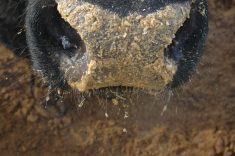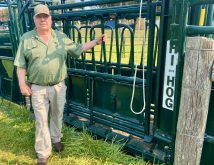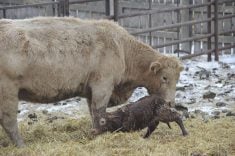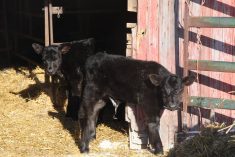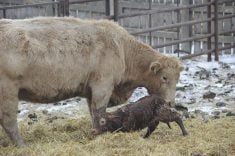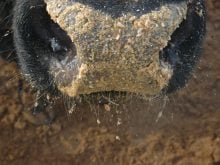Patience, an ability to read cattle and knowing the pastures and terrain can make all the difference when handling cattle
Cattle respond to good handling by becoming easy to manage. If mishandled, they react with suspicion or fear when they see people and become difficult to handle.
Consistent, non-confrontational methods can build trust in a herd.
Al Fenton of Fenton Herefords near Irma, Alta., has been raising Herefords for decades and has 700 registered cows, as well as Quarter horses.
He says the cattle have good dispositions and are easy to handle, partly due to genetic selection but also because they are handled with the same patient techniques used when training horses.
“We handle all our cattle on horses. When sorting large groups, we gather and hold them in a group. … When we trail to pasture several miles away, they line out and know what we want,” he says.
“When we hold a group, we make them stay. If a heifer wants to take off, we don’t chase her. A rider just circles around her. Most of the time they won’t run far. We let them stand a minute and then a rider can walk around and put them back in the bunch and continue to hold until all of them are settled. We never move cattle until they settle.”
Fenton says this technique also teaches the horses being used.
“Doing it slowly is faster. Everything works better and saves time. If you give cattle time to figure it out, it teaches them to think and wait and look for your instruction rather than trying to look for the first way out.”
He advises using cattle’s desire to remain in familiar groups, which keeps them calm. “When gathering, we often have two or three riders hold that group while other riders bring more cattle out of the bush. Most of those cattle will head for the group being held.
“If you do it the right way, the cattle will do a lot of the gathering and sorting for you. It takes patience, and I wish I’d had more patience when I was younger, but sometimes that has to come with experience,” says Fenton.
“We just hold a group and sort out pairs we want. One or two riders move quietly through the group. The cattle won’t scatter because they are content and feel secure in that group and when you go in to pull a pair out you can just quietly bump that pair to the outside edge.”
He chooses an animal he expects to stay calm and holds it about 200 metres away from the group. Then other animals are added, assisted by riders.
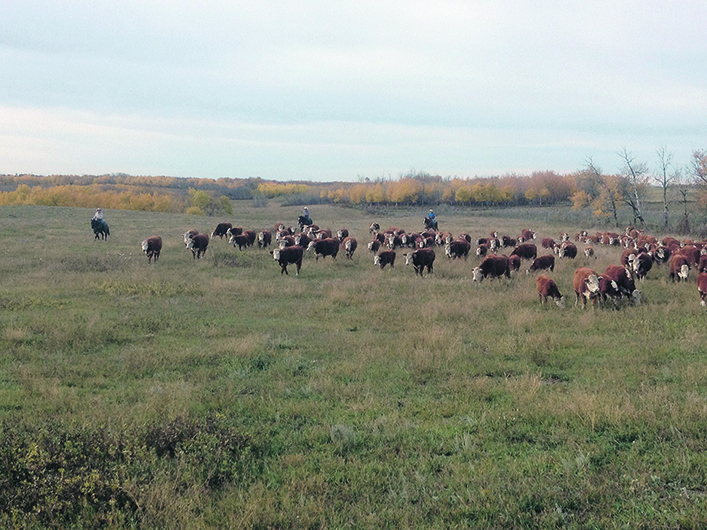
“Then when you need more room, as you get a bigger group sorted out, you just move them a little farther away from the main herd and stop them,” he says.
He generally sorts into groups of 30, held at a spot in the pasture without the turmoil often seen when cattle are worked in a corral.
“The cattle know what to expect, and sort quietly and easily, and this avoids shrink. It takes fewer riders. As the heifers get older it becomes easier.”
Fenton’s grandchildren often do the riding and are learning how to manage a herd gently by reading the animals’ body language and natural tendencies.
“The cow can be going the wrong direction and you can still win. If the cow is going out of the herd, she is just getting freed up from the group and you can ease around her and bring her back nice and easy.
“If you are 30 or 50 feet away, she doesn’t feel as uncomfortable. You are not intruding on her space but she can still feel your pressure. She’ll stay calmer. It’s important to take time and let the cow think through it. If you press her too hard, she won’t try to think. She’ll take off blindly.”
In a corral situation, Fenton advises planning ahead. Fancy facilities aren’t necessary if the cattle are already trained to be manageable.

“Use the way they think to your advantage and let them to think it’s their idea. If cattle are calm and know where they are going, you give them an easy out and they take it, without being stressed. It’s just like training a horse; make the right thing easy and the wrong thing harder.
“The yelling and screaming that happens in many corrals puts stress on cattle, the work crew and families. That stress will go away if you put enough thought into how you’ll sort those cattle,” says Fenton.
“One thing many people don’t understand is that if you are making noise, you are distracting the cattle, taking their focus away from what they should be thinking, about where they are going, and directing it to you instead. You don’t want them looking at you. You want them looking at the gate. The more you can let them think for themselves, and have the flow the right direction, the more you win.”





